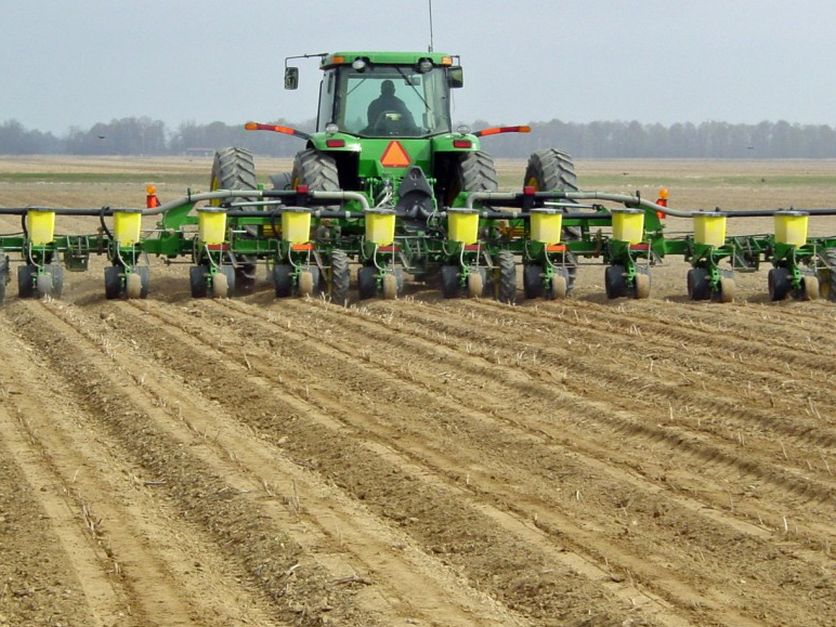U.S. farmers planted 6% more corn acres this spring than last year but 5% fewer soybean acres, which is likely to drive U.S. soybean exports lower because of tighter supplies and higher prices.
USDA released its acreage report and quarterly grain stocks report Friday, revealing corn planted area at 94.1 million acres, up 5.52 million acres from last year. USDA said this is the third highest planted acreage since 1944, with acreage up or unchanged in 43 of 48 states. Area harvested for corn grain is up 9% from last year at 86.3 million acres.
“Feed grains won in terms of what producers planted,” with sorghum acres also up almost a half million acres, said Mike Zuzolo, president of Atchison, Kansas-based Global Commodity Analytics & Consulting. However, he added the lower soybean acres likely will send soybean meal prices higher.
Zuzolo said the higher corn acreage benefited from better weather this season, but also because fertilizer prices fell ahead of spring planting.
“It is a surprise to me that we have this big of an increase,” Zuzolo said. In May, USDA estimated harvested corn acreage at 84.1 million acres before updating it to 86.3 million acres in Friday’s report. That excess 2.2 million harvested acres likely will increase corn carryover stocks by about 400 million bushels, putting pressure on corn prices..
The National Agricultural Statistics Service estimated soybean planted area at at 83.5 million acres, which is down or unchanged in 21 of the 29 soybean states. NASS projected 8.22 million acres of soybean still need to be planted, about half last year’s level at the same time..
“I suspect we’ll be driving the November beans towards a 150- to 175-bushel carryover,” which would suggest beans could get back up into the upper $13 to lower $14 range, Zuzolo said. The market will now have to grapple with lower stocks and fewer acres, creating a situation where demand rationing is going to be needed, he said.
Soybean exports will be the “big loser” because of the need to ration soybean demand, Zuzolo said, with market prices out of the Gulf of Mexico $3.25 a bushel higher than Brazil and even higher prices out of the Pacific Northwest. He said he expects the U.S. to be the soybean “seller of last resort” as it is uncompetitive in the world market..
Some soybeans will get double-cropped behind wheat acres. However, Zuzolo said both hard red wheat and soft winter wheat harvest is behind schedule. Zuzolo said both hard red wheat and soft winter wheat harvest is behind schedule, and regions for both those wheat varieties have been able to receive adequate to excess moisture, which is part of the reason for the delayed harvest.
“Producers, especially in hard red winter wheat country, I think would be willing to take on added risk even if they don’t have crop insurance and go after some extra soybean double-crop acres,” he said.
However, it’s probably not enough to offset what USDA reported in Friday’s report as planting those acres will still require cooperative weather. The window closes by mid-July in most of those regions to get adequate pod fill ahead of a November freeze.
Wheat planted area for 2023 is estimated at 49.6 million acres, up 9% from last year. Soft red wheat producers were eager to add acres, Zuzolo said, and USDA said acreage was higher at 7.66 million acres planted. USDA estimated other spring wheat planted area at 11.1 million acres, up 3%.
“Spring wheat acreage probably recovered as the drought faded from that area, which was terrible last year,” Zuzolo said.
Ahead of the next World Agricultural Supply and Demand Estimates (WASDE) report on July 12, USDA will take these acreage numbers and balance them against fresh yield numbers, he said.
The vegetable oil and biodiesel markets will probably still be able to perform and keep their margins intact because of government subsidies at the higher soybean prices, but, livestock producers will struggle to pay for higher soybean meal, Zuzolo said
With the same cocktail of low hog prices and high soybean meal prices, minus lower corn prices by 10% or 15%, margins remain dismal.
Don’t miss a beat! It’s easy to sign up for a FREE month of Agri-Pulse news! For the latest on what’s happening in Washington, D.C. and around the country in agriculture, just click here.
“We have a livestock market on life support right now, especially for hogs and poultry,” Zuzolo said, as producers struggle with disease and below breakeven production costs. “The next three to four months we might see a second liquidation pressure as a result of this.”
He added, “I don’t think the livestock side can take much more in terms of either of the feed side being higher. or they need higher per animal prices at the gross level to take themselves out of the hole they’re already in.”
Although new crop corn acres are promising, the grain stocks showed farmers are still holding onto last year’s corn crop in on-farm storage. Of the total 4.11 billion bushels of stored corn, 2.22 billion bushels are stored on farms, up 5% from a year earlier.
Zuzolo said when producers saw their production costs increase and the threat of a drought in the Eastern Corn Belt, it incentivized some to hold onto their grain. With rain on the radar screen, however, producers may finally let go of some of their 2022 corn and “throw in the towel at this point” without the possibility of a weather rally or supply shortage.
USDA said soybeans stored as of June 1 totaled 796 million bushels, down 18% from June 1, 2022. On-farm stocks were 323 million bushels, down 3%.
“The market is very fickle this time of year, and even with a bearish corn report and with the beans looking strong, the funds may decide to come back in and buy this market,” Zuzolo said.
For more news, visit www.Agri-Pulse.com.


